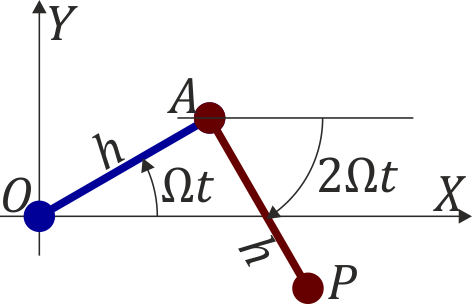Partícula unida a un sistema articulado
De Laplace
(Diferencias entre revisiones)
(Página creada con '==Enunciado== Se tiene un sistema articulado formado por dos barras de la misma masa y la misma longitud <math>h</math> situadas sobre una superficie horizontal. La primera barr…') |
|||
| Línea 13: | Línea 13: | ||
<center>[[Archivo:barras-articuladas-rotatorias-2.png]]</center> | <center>[[Archivo:barras-articuladas-rotatorias-2.png]]</center> | ||
==Ecuaciones horarias== | ==Ecuaciones horarias== | ||
| + | Podemos halalr la posición instantánea mediante una suma vectorial | ||
| + | |||
| + | <center><math>\overrightarrow{OP}=\overrightarrow{OA}+\overrightarrow{AP}</math></center> | ||
| + | |||
| + | siendo | ||
| + | |||
| + | <center><math>\overrightarrow{OA}=h\cos(\Omega t)\vec{\imath}+h\,\mathrm{sen}(\Omega t)\vec{\jmath}</math></center> | ||
| + | |||
| + | y | ||
| + | |||
| + | <center><math>\overrightarrow{AP}=h\cos(-2\Omega t)\vec{\imath}+h\,\mathrm{sen}(-2\Omega t)\vec{\jmath}=h\cos(2\Omega t)\vec{\imath}-h\,\mathrm{sen}(2\Omega t)\vec{\jmath}</math></center> | ||
| + | |||
| + | lo que da | ||
| + | |||
| + | <center><math>\vec{r}=\overrightarrow{OP}=`h\left(\cos(\Omega t)+\cos(2\Omega t)\right)\vec{\imath}+h\left(\mathrm{sen}(\Omega t)-\mathrm{sen}(2\Omega t)\right)\vec{\jmath}</math></center> | ||
| + | |||
==Magnitudes en t=0 == | ==Magnitudes en t=0 == | ||
== Magnitudes en t = π/(2Ω)== | == Magnitudes en t = π/(2Ω)== | ||
[[Categoría:Problemas de cinemática tridimensional de la partícula (GIE)]] | [[Categoría:Problemas de cinemática tridimensional de la partícula (GIE)]] | ||
Revisión de 18:06 29 oct 2015
Contenido |
1 Enunciado
Se tiene un sistema articulado formado por dos barras de la misma masa y la misma longitud h situadas sobre una superficie horizontal. La primera barra tiene un extremo O fijo, de forma que gira alrededor de él con velocidad angular constante Ω respecto a un sistema de ejes fijos OXY. La segunda barra está articulada en el extremo A de la primera y gira respecto de los mismos ejes fijos con una velocidad angular − 2Ω. En el instante t = 0 el sistema está completamente extendido a lo largo del eje OX.
- Escriba las ecuaciones horarias de la posición del punto B para todo instante.
- Para el instante t = 0 halle
- La velocidad y la rapidez.
- La aceleración como vector y sus componentes intrínsecas (escalares).
- El radio y el centro de curvatura.
- Para el instante t = π / (2Ω) calcule
- La velocidad y la rapidez.
- La aceleración como vector y sus componentes intrínsecas (escalares).

2 Ecuaciones horarias
Podemos halalr la posición instantánea mediante una suma vectorial

siendo

y

lo que da





